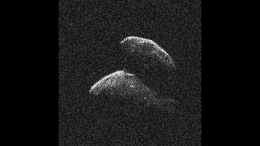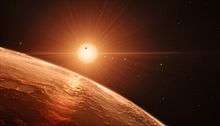2014 JO25
 Radar image of 2014 JO25 taken at Goldstone on 19 Apr 2017 | |
| Discovery [1] | |
|---|---|
| Discovered by | Mount Lemmon Srvy. |
| Discovery site |
Mount Lemmon Obs. (first observation only) |
| Discovery date | 5 May 2014 |
| Designations | |
| MPC designation | 2014 JO25 |
| NEO · Apollo · PHA [1][2] | |
| Orbital characteristics [1] | |
| Epoch 23 March 2018 (JD 2458200.5) | |
| Uncertainty parameter 0 | |
| Observation arc | 6.02 yr (2,200 days) |
| Aphelion | 3.8996 AU |
| Perihelion | 0.2364 AU |
| 2.0680 AU | |
| Eccentricity | 0.8857 |
| 2.97 yr (1,086 days) | |
| 125.06° | |
| 0° 19m 53.04s / day | |
| Inclination | 25.261° |
| 30.637° | |
| 49.571° | |
| Earth MOID | 0.0110 AU (4.3 LD) |
| Mercury MOID | 0.0210 AU[2] |
| Venus MOID | 0.0412 AU[2] |
| Physical characteristics | |
Mean diameter |
0.72 km (est. at 0.20)[3] 0.818 km (calculated)[4] |
| 4.531 h[4] | |
| 0.20 (assumed)[4] | |
| S (assumed)[4] | |
| 17.8[4] · 18.1[1] | |
|
| |
2014 JO25 is asteroid. It was discovered in May 2014 by astronomers at the Catalina Sky Srvey near Tucson,Arizona-a project of NASA's NEO Observations Program in collaboration with the University of Arizona.(An NEO is a near-Earth object).
Orbit and classification
2014 JO25 belongs to the Apollo asteroids, which cross the orbit of Earth. Apollos are the largest group of near-Earth objects with nearly 10 thousand known members. It is also a potentially hazardous asteroid due to its sufficiently large size (an absolute magnitude brighter than 22), and its Earth-MOID (see below) of less than 0.05 AU.
It orbits the Sun at a distance of 0.25–3.90 AU once every 3 years (1,086 days; semi-major axis of 2.07 AU). Its orbit has an eccentricity of 0.89 and an inclination of 25° with respect to the ecliptic.[1] This makes it also an Venus- and Mercury-crossing asteroid.
The body's observation arc begins with a precovery taken by Pan-STARRS in May 2011, or 3 years prior to its official first observation at Mount Lemmon.[2]
Close approaches
This asteroid has an minimum orbital intersection distance (MOID) with Earth of 1,650,000 km; 1,020,000 mi (0.0110 AU), which translates into 4.3 lunar distances.[1]
2017 Earth flyby
2014 JO25 made a close flyby of Earth on 19 April 2017, and at its closest approach on that date came within 1.8 million kilometers (1.1 million miles) of the planet. It reached an apparent magnitude of 10.76.
The 2017-flyby within a distance of 1.8 million kilometers was the closest approach to Earth by 2014 JO25 for at least the next 400 years.[5]
| PHA | Date | Approach distance in lunar distances | Abs. mag (H) |
Diameter (C) (m) |
Ref (D) | ||
|---|---|---|---|---|---|---|---|
| Nominal(B) | Minimum | Maximum | |||||
| (33342) 1998 WT24 | 1908-12-16 | 3.542 | 3.537 | 3.547 | 17.9 | 556–1795 | data |
| (458732) 2011 MD5 | 1918-09-17 | 0.911 | 0.909 | 0.913 | 17.9 | 556–1795 | data |
| (7482) 1994 PC1 | 1933-01-17 | 2.927 | 2.927 | 2.928 | 16.8 | 749–1357 | data |
| 69230 Hermes | 1937-10-30 | 1.926 | 1.926 | 1.927 | 17.5 | 668–2158 | data |
| 69230 Hermes | 1942-04-26 | 1.651 | 1.651 | 1.651 | 17.5 | 668–2158 | data |
| (137108) 1999 AN10 | 1946-08-07 | 2.432 | 2.429 | 2.435 | 17.9 | 556–1795 | data |
| (33342) 1998 WT24 | 1956-12-16 | 3.523 | 3.523 | 3.523 | 17.9 | 556–1795 | data |
| (163243) 2002 FB3 | 1961-04-12 | 4.903 | 4.900 | 4.906 | 16.4 | 1669–1695 | data |
| (192642) 1999 RD32 | 1969-08-27 | 3.627 | 3.625 | 3.630 | 16.3 | 1161–3750 | data |
| (143651) 2003 QO104 | 1981-05-18 | 2.761 | 2.760 | 2.761 | 16.0 | 1333–4306 | data |
| 2017 CH1 | 1992-06-05 | 4.691 | 3.391 | 6.037 | 17.9 | 556–1795 | data |
| (170086) 2002 XR14 | 1995-06-24 | 4.259 | 4.259 | 4.260 | 18.0 | 531–1714 | data |
| (33342) 1998 WT24 | 2001-12-16 | 4.859 | 4.859 | 4.859 | 17.9 | 556–1795 | data |
| 4179 Toutatis | 2004-09-29 | 4.031 | 4.031 | 4.031 | 15.30 | 2440–2450 | data |
| 2014 JO25 | 2017-04-19 | 4.573 | 4.573 | 4.573 | 17.8 | 582–1879 | data |
| (137108) 1999 AN10 | 2027-08-07 | 1.014 | 1.010 | 1.019 | 17.9 | 556–1795 | data |
| (35396) 1997 XF11 | 2028-10-26 | 2.417 | 2.417 | 2.418 | 16.9 | 881–2845 | data |
| (154276) 2002 SY50 | 2071-10-30 | 3.415 | 3.412 | 3.418 | 17.6 | 714–1406 | data |
| (164121) 2003 YT1 | 2073-04-29 | 4.409 | 4.409 | 4.409 | 16.2 | 1167–2267 | data |
| (385343) 2002 LV | 2076-08-04 | 4.184 | 4.183 | 4.185 | 16.6 | 1011–3266 | data |
| (52768) 1998 OR2 | 2079-04-16 | 4.611 | 4.611 | 4.612 | 15.8 | 1462–4721 | data |
| (33342) 1998 WT24 | 2099-12-18 | 4.919 | 4.919 | 4.919 | 17.9 | 556–1795 | data |
| (85182) 1991 AQ | 2130-01-27 | 4.140 | 4.139 | 4.141 | 17.1 | 1100 | data |
| 314082 Dryope | 2186-07-16 | 3.709 | 2.996 | 4.786 | 17.5 | 668–2158 | data |
| (137126) 1999 CF9 | 2192-08-21 | 4.970 | 4.967 | 4.973 | 18.0 | 531–1714 | data |
| (290772) 2005 VC | 2198-05-05 | 1.951 | 1.791 | 2.134 | 17.6 | 638–2061 | data |
| (A) This list includes near-Earth approaches of less than 5 lunar distances (LD) of objects with H brighter than 18. (B) Nominal geocentric distance from the center of Earth to the center of the object (Earth has a radius of approximately 6,400 km). (C) Diameter: estimated, theoretical mean-diameter based on H and albedo range between X and Y. (D) Reference: data source from the JPL SBDB, with AU converted into LD (1 AU≈390 LD) (E) Color codes: unobserved at close approach observed during close approach upcoming approaches | |||||||
Physical characteristics
2014 JO25 is a peanut-shaped contact binary. It is an assumed stony S-type asteroid.[4]
Diameter and albedo
Early estimation based on observed absolute magnitude and estimated albedo indicates object 600–1400 meters (m) in diameter. In 2014, further research based on NEOWISE data indicated an object of 650 m in diameter and albedo 0.25.[6]
Based on a generic magnitude-to-mean-diameter conversion, 2014 JO25 measures approximately 720 m in diameter, using an absolute magnitude of 18.1 and assuming an albedo of 0.20, which is typical for stony asteroids.[3] The Collaborative Asteroid Lightcurve Link assumes an albedo of 0.20 and calculates a diameter of 818 meters based on an absolute magnitude of 17.8.[4]
Observation of the asteroid with the Goldstone Solar System Radar were performed between April 15 and 21, 2017 by Arecibo Observatory and Goldstone Solar System Radar. Results show that the largest dimension of this contact binary is at least 870 meters.[4][7]
Rotation period
The 2017 radiometric observations at Arecibo and Goldstone also gave a rotation period of approximately 4.5 hours.[7] Also in April 2017, a rotational lightcurve of this asteroid was obtained from photometric observations by Brian Warner at the Palmer Divide Station (U82) in California. Lightcurve analysis gave a refined period of 4.531 hours with a brightness amplitude between 0.14 and 0.64 magnitude (U=n.a.).[8]
Numbering and naming
As of 2018, this minor planet has not been numbered or named.[2]
Gallery
Radar images of the asteroid were taken on 18 April 2017 by the Goldstone Solar System Radar:
 Radar images of 2014 JO25
Radar images of 2014 JO25
 Telescopic view 2017-4-19 22:07:35 - 22:31:07 UTC
Telescopic view 2017-4-19 22:07:35 - 22:31:07 UTC
References
- 1 2 3 4 5 6 "JPL Small-Body Database Browser: (2014 JO25)" (2017-05-24 last obs.). Jet Propulsion Laboratory. Retrieved 21 February 2018.
- 1 2 3 4 5 "2014 JO25". Minor Planet Center. Retrieved 21 February 2018.
- 1 2 "Asteroid Size Estimator". CNEOS NASA/JPL. Retrieved 21 February 2018.
- 1 2 3 4 5 6 7 8 "LCDB Data for 2014 JO25". Asteroid Lightcurve Database (LCDB). Retrieved 21 February 2018.
- ↑ http://earthsky.org/astronomy-essentials/large-asteroid-2014-jo25-close-april-19-2017-how-to-see
- ↑ https://echo.jpl.nasa.gov/asteroids/2014JO25/2014JO25_planning.html
- 1 2 "Planetary Radar Science Group". National Astronomy and Ionosphere Center (NAIC). Retrieved 21 February 2018.
- ↑ Warner, Brian D. (October 2017). "Lightcurve Analysis of Two Near-Earth Asteroids: 2010 VB1 and 2014 JO25". The Minor Planet Bulletin. 44 (4): 327–330. Bibcode:2017MPBu...44..327W. ISSN 1052-8091. Retrieved 21 February 2018.
External links
| Wikimedia Commons has media related to 2014 JO25. |
- Asteroid to Fly Safely Past Earth on April 19, NASA news
- PIA21597: New Radar Images of Asteroid 2014 JO25, NASA/JPL, Photojournal
- 2014 J025 Earth Flyby Trajectory Animation
- See A Potentially Hazardous Asteroid Zip By Earth Wednesday Bob King, April 17, 2017
- The Face Of Earth-Approacher 2014 JO25 Bob King, April 19, 2017
- Asteroid 2014 JO25 Echoes Back Its Secrets Bob King, May 16, 2017
- NASA captures images of large asteroid flying by Earth FOX News, 20 April 2017
- 2014 JO25 at the JPL Small-Body Database


